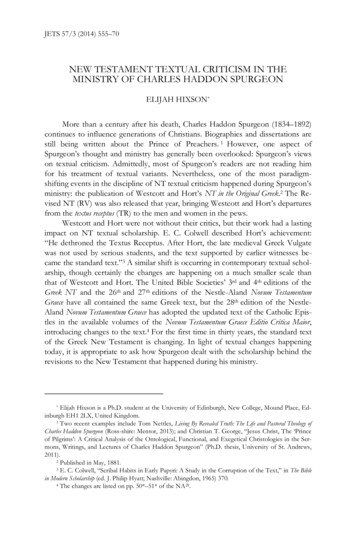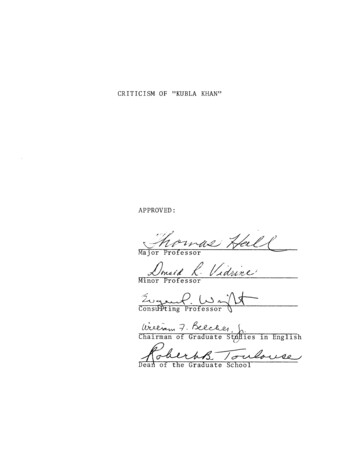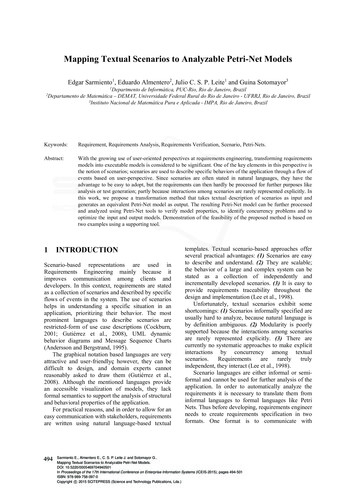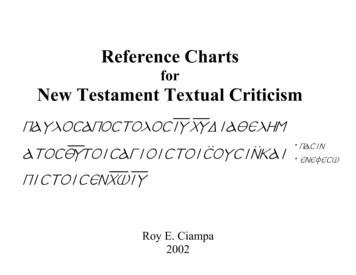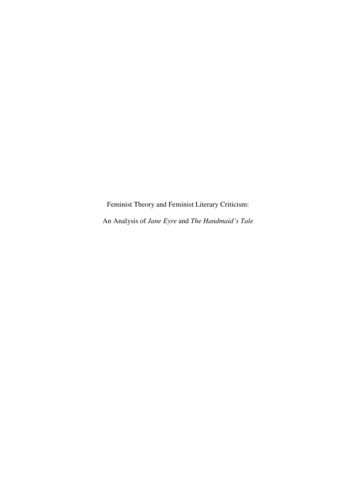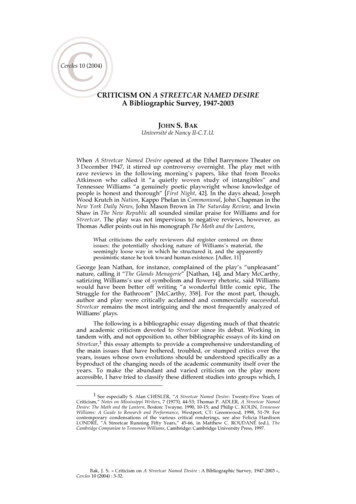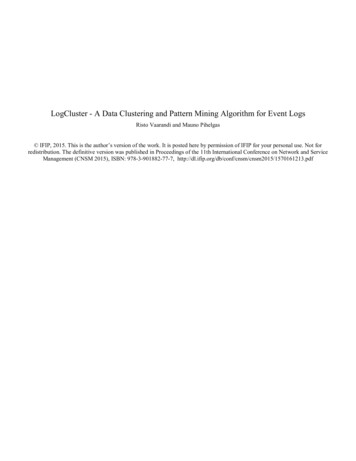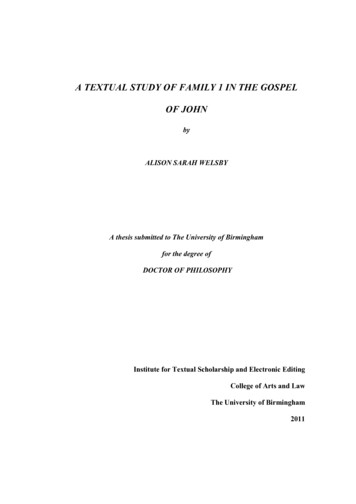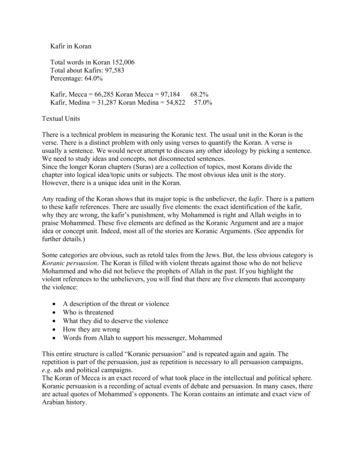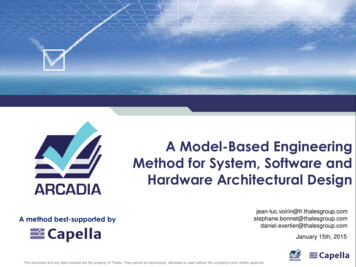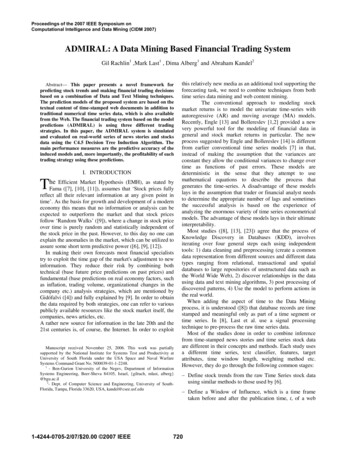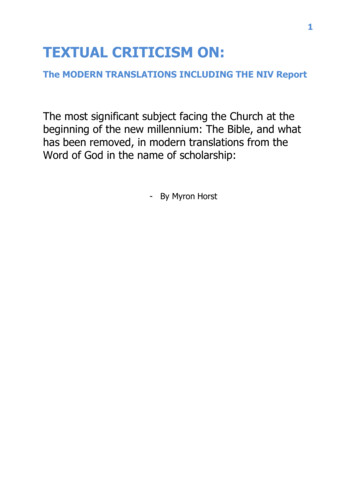
Transcription
1TEXTUAL CRITICISM ON:The MODERN TRANSLATIONS INCLUDING THE NIV ReportThe most significant subject facing the Church at thebeginning of the new millennium: The Bible, and whathas been removed, in modern translations from theWord of God in the name of scholarship:- By Myron Horst
2Table of Contents2 -3The Greek Text of the Modern Translations including theMODERN TRANSLATIONS INCLUDING THE NIV4Section 1The Greek TextsThe Preciseness of the Greek Language 5The MODERN TRANSLATIONS INCLUDING THE NIV’s “best manuscripts” . 7Codex SinaiticusCodex VaticanusThere are many gaps in the logic supporting the MODERN TRANSLATIONSINCLUDING THE NIV Greek Text . 8None of their Ancient Manuscripts Agree with each otherNo Manuscript Proof to support Codex Vaticanus and Codex Sinaiticus . 9The UBS 3rd Edition is a 20th Century "Manuscript"What does eclectic mean? 10Reason given in the man made eclectic text for selecting this reading . 11Is the Textus Receptus based on one ancient Greek manuscript ?Is the Textus Receptus eclectic? . 12Why aren't the same standards used ?A further testimony that the NU Greek text is not reliable . 13In many of the passages it is "meat" that has been removedA deceptive argument that no essential doctrine has been removedThe term "doctrine" has been almost totally removed in the MODERNTRANSLATIONS INCLUDING THE NIV .14The phrase order of many verses has been significantly changed in the MODERNTRANSLATIONS INCLUDING THE NIVThe deception the Bible easier to understand . 15GOD'S WORD IS PURE, IS TRUTH, AND IS NOT TO BE ALTEREDWhy are we not to add to or remove from God's words? 16What happens when God's words are added to or removed?What does God say? . 17How many variations is the work of Satan? . 18Why the Textus Receptus can be trusted as having the Words of God . 19Section 2 What has been changed in the Modern Greek Text20The following passages address facts that are easily verifiedThe Deity of Jesus Christ and His Lordship 21Salvation and the Judgment . 25Jesus . 29The Holy Spirit . 31Angels . 31Prayer and Fasting . 32Communion . 32Crucifixion and Resurrection . 35Divorce and RemarriageFornicationForgivenessUnity of thought . 36Listening To God
3Pharisees and ScribesAdditional Changes .37Section 3 Manuscript evidence given by the UBS Greek TextThere are a number of things for you to observe in this section . 57The Deity of Jesus Christ and His Lordship 58Salvation and the Judgment . 62The MODERN TRANSLATIONS INCLUDING THE NIV is not aliteral translationSection 4Inaccurate translation of words in the MODERN TRANSLATIONS INCLUDINGTHE NIV 68Deity of ChristSalvationDivorce and RemarriagePrayer Veiling . 69Unity of thought . 70The Name "Jesus"Child Training . 71Corporal punishmentForgivenessDebtFornicationAdditional InaccuraciesThe MODERN TRANSLATIONS INCLUDING THE NIV is affectingthe Church’s doctrineSection 5What does "I Believe what the Bible says" mean? .We Wrestle not against flesh and Blood . .The Ph.D. pedestal .The MODERN TRANSLATIONS INCLUDING THE NIV and KJV cannot bothcalled good translations . 76What translation should I use?737475beAddendum .What about the NASV?The New American Standard Version .Frank Logsdon goes on to address what the multitude oftranslations are doing in the Church Additional Information 80Conclusion818384
4Section 1The Greek Text of the Modern Translationsincluding the MODERN TRANSLATIONSINCLUDING THE NIVThe most significant subject facing the Church in the 21st Century is the Bible, itsGreek text, and the way it is translated. Every Christian doctrine is based on theBible. The way the Bible reads, the words that it has and the words that itdoes not have, the way the Greek words are translated or poorlytranslated, all affect the doctrine of the Church. At one point I thought thatmost translations of the Bible were basically the same except for the modernizationof the old English in the KJV. As you will see for yourself, this is not the case. Mostof the modern translations do not have everything that the KJV does, as a result ofchanges in the Greek texts from which they are translated.God tells us that the Bible is pure, is truth, and words are not to be added to orremoved from it. However when two translations of the Bible say two differentthings in the same verse, subconsciously people's trust in the purity, and absolutetruth of the Bible is eroded. When two translations say different things, which one istruth? Or are they both what God said? Christians then have to become judges ofScripture and pick which reading they like best. Therefore you hear "I like the way itsays it in this translation," rather than "This is what God says."As Christians we need to know what is truth, and what translations of theBible can be trusted as having all the Words of God. We need a firm foundation,not the shifting sand of Bible versions in which the words are continually changing.My desire is that in the pages of this book you will find which translations can befully trusted as having all the Words of God, and which translations are based on aGreek text that is constantly changing and cannot be trusted as having all theWords of God.The purpose of this booklet is to share with you what has been removed from andadded to the Word of God in the modern Greek text, and to alert you to theseriousness of the problems that result in the MODERN TRANSLATIONS INCLUDINGTHE NIV as well as most of the other modern Bible translations — TheContemporary English Version, The New American Standard Version, TheAmerican Standard Version, The Revised Standard Version, The Living Bible, TheNew Revised Standard Version, The New Jerusalem Bible, The New American Bible,and others. You will find that these translations, which are translated from the samecorrupt modern Greek text as the MODERN TRANSLATIONS INCLUDINGTHE NIV, are missing many of the same words, phrases, and entire verses as theMODERN TRANSLATIONS INCLUDING THE NIV.The Greek texts
5The main problem with the MODERN TRANSLATIONS INCLUDING THE NIV is in theNew Testament with the Greek text that it was translated from.The main issue is not how the MODERN TRANSLATIONS INCLUDING THE NIVtranslates words, although there are also many problems there and many havedocumented it, but the Greek text that the MODERN TRANSLATIONSINCLUDING THE NIV was translated from - the United Bible Societies 3rdedition (UBS 3rd) and the Nestle-Aland text, 26th edition. (These two textshave exactly the same wording.)THERE ARE TWO MAIN GREEK TEXTS USED TODAY FOR TRANSLATINGENGLISH BIBLES: The Textus Receptus (The Received Text), and theNestle-Aland/UBS text. This may some times be referred to as the NU text.The preciseness of the Greek languageIt is interesting the way that God chose the languages to write down His Word Hebrew and Greek. The following is from Wisdom Booklet One of the AdvancedTraining Institute Curriculum:(footnote 2 – pg79)"The Hebrew language is very picturesque. Its sentences are short andintensely expressive. The Old Testament is primarily biographical. Hebrew usesvivid and bold metaphor, graphically describing events and their results. Hebrew is avery personal language; even nations are given personality. God reveals Himself indescriptive human terms - attributing to Himself human characteristics and emotions- to aid man in understanding His character."Greek is a precise, highly technical language. It leaves little room forspeculation regarding the intent of the author."In the New Testament the explanation of ideas and concepts is paramount. Many ofthe verses explain and amplify the rich symbolism of the Old Testament."Whereas Hebrew was largely confined to the nation of Israel, Greek was aworldwide language and was able to convey clearly and accurately the good news ofsalvation." 2The preciseness of the Greek language is an important concept for us tokeep in mind. There are those who would like us to think that there is a lot offlexibility and or difficulty in translating from the Greek into English. While that maybe true for some Greek words, the preciseness of the Greek language enablesus to know with a great deal of certainty what God's Word actually is.THERE IS NO ANCIENT MANUSCRIPT THAT READS THE SAME AS THEMODERN UNITED BIBLE SOCIETIES 3RD EDITION GREEK TEXT!
6I discovered that there has never existed an ancient Greek manuscriptthat reads the same as the Nestle and United Bible Society's Greek textthat the MODERN TRANSLATIONS INCLUDING THE NIV, NASB, and mostother modern translations are translated from. These modern translationshave not been translated from an ancient Greek manuscript, but from a modernman-made Greek text that was compiled from a hand full of ancientmanuscripts (primarily from 2 manuscripts) which have many variantreadings and many omissions. The Nestle Aland and United Bible Society'sGreek text (NU Greek text) is the equivalent of a 20th century Greek"manuscript" (The NU is a text not a manuscript because it is not handwritten.) since no one has a ancient Greek manuscript that reads the sameas it does. THEREFORE THE MODERN TRANSLATIONS INCLUDING THE NIVIS NOT TRANSLATED FROM THE OLDEST MANUSCRIPTS BUT FROM A NEWGREEK TEXT. THIS IS AN IMPORTANT POINT TO REMEMBER.The NU text is an eclectic Greek text. This is the term used in the preface of theMODERN TRANSLATIONS INCLUDING THE NIV Bible to describe it. The term"eclectic" is defined by The World Book Dictionary 1982 edition as: "Selecting andusing what seems best from various sources, systems, or schools ofthought." Webster's New Twentieth Century Dictionary (Unabridged) defineseclectic as: "Selecting; choosing; not original nor following any one modelor leader, but choosing at will from the doctrines, works, etc., of others."The NU is a text that has been pieced together by scholars with readings selectedfrom various ancient manuscripts in an attempt to assemble a text that they think isclosest to the original manuscripts. This sounds like a noble and righteous attempt atfirst until one realizes that the result is a man-made text that is different from allexisting ancient Greek manuscripts.The UBS 3rd and Nestle Aland texts are based on only a few manuscriptsthat don't agree with each other or with the majority. You will see how fewin the chapter: Manuscript evidence given by the UBS Greek text. You will also beable to see that these manuscripts do not agree with each other. The few numberof Greek manuscripts that the changes in the MODERN TRANSLATIONSINCLUDING THE NIV is based on is shocking when one realizes that thereare over 5000 New Testament manuscripts and the weight of the rest haslargely been ignored even though there are other manuscripts that are ofthe same age and the majority are in agreement.A significant issue is that the Greek manuscripts that we are being told arethe "best" do not agree with each other. They do not read the same. Thedifferences are significant differences in reading. These are not minor differences,such as differences in spelling, word order, or punctuation. Among the two mainmanuscripts (Codex Sinaiticus and Codex Vaticanus) upon which the NU text isbased, there are many, many, many places where one of them will omit a significantword or phrase and the other will have the word or phrase. I have not found anyscholar that refutes the fact that among the Alexandrian manuscripts upon which themodern NU Greek text (Nestle Aland/ United Bible Society text) is based, that thereare not two manuscripts that read the same. In fact they testify to the fact that their
7"best" manuscripts do not agree because they have had to compile an eclectic Greektest. They have selected from the variant readings what they think might be the bestreading. The result is that not only do their ancient manuscripts not agreewith each other, but the resulting Greek text from which the MODERNTRANSLATIONS INCLUDING THE NIV is translated does not agree withany ancient Greek manuscript. It does not read the same as any ancientGreek manuscript. (Note: this is in sharp contrast to the agreement inreading of the large group of manuscripts that the Textus Receptus isbased on.)The term "best manuscripts" needs to be understood from the view point of highlyeducated scholars who are looking at the quality of the manuscript parchment, howlittle is missing, and the age of the manuscript. The term "best" is not how manyChristians interpret it in thinking about the Word of God, that best means the text isvery accurate and reliable.The MODERN TRANSLATIONS INCLUDING THE NIV's "bestmanuscripts"From my research in examining the NU Greek text, most of what has beenremoved from the MODERN TRANSLATIONS INCLUDING THE NIV, is basedon Codex Sinaiticus, and Codex Vaticanus. These are the oldest manuscriptsthat are listed in the footnotes of the United Bible Society's 3rd. edition Greektext for the majority of the passages where something has been removed.The following is what I have found about these two texts:Codex SinaiticusThis codex is an Alexandrian (Egyptian) manuscript dating from the fourth century(350 AD; around 275 years after most of the New Testament books were originallywritten). The scribe has many careless and transcriptional errors. Letters, words, andwhole sentences are written twice or begun the second time and immediately struckout. There are 115 times in the N.T. where a clause is omitted because it happens toend in the same words as the clause before it. It has had many alterations to correctthe careless mistakes. Dean Burgon, who has studied it, says that elevendifferent persons have made revisions and corrections on the manuscriptitself down through the ages.3 It was discovered in a monastery trashcan.4 (Footnote)Codex VaticanusThis codex is also an Alexandrian (Egyptian) manuscript dating from the fourthcentury (350 AD; around 275 years after the most of the New Testament bookswere originally written). It has been held by the Vatican since the mid 1400's butwas not released to Protestant scholars until the late 1800's. The Vatican will not let
8scholars study the original. Only a few have been allowed to see it, and then only forshort periods. Scholars have only had photocopies to work from.5 (Footnote)There are literally thousands of omissions, additions, and other changes in each ofthese manuscripts. What is significant is that where they differ from the way themajority of the Greek manuscripts read, the omissions, additions, and other changesare not the same in both manuscripts. These two manuscript do not read the same,they are not identical.There are major gaps in the logic supporting the MODERNTRANSLATIONS INCLUDING THE NIV's Greek textThose who write in support of the MODERN TRANSLATIONS INCLUDING THE NIVsound convincing. However, I encourage you to evaluate carefully what they aresaying. I have discovered that there are major gaps in the logic for the moderneclectic Greek text. Often there are opinions that are stated as facts without ancientmanuscript proof given to back up what they are confidently saying. An example ofthis is in explaining why a particular phrase is not in the NU Greek text, they state:that a particular phrase is clearly an example of a later scribe adding aphrase to make it read like another passage. They do not give the manuscriptsthat contain the phrase and the ones that do not, and the dates of the manuscriptsso that you can judge for yourself that it is clearly inserted by a later scribe. When Iwould look up the evidence on the phrase, I would find that it was not as they madeit appear. Often I found evidence (For example, the writings of the early churchfathers) that was at least the same age and sometimes older than the manuscriptthat did not have the phrase, that included the phrase.They also write from the premise that the early Alexandrian/Egyptian manuscripts,especially Codex Vaticanus and Codex Sinaiticus, read closest to the originals. I raisethis question: "Why would the Alexandrian/Egyptian manuscripts read closest to theoriginals when most of the original copies of the New Testament books were sent toAsia which was on the other side of the Mediterranean Sea?" None of the originalbooks of the New Testament were sent to Egypt.In addition, those who write in support of the MODERN TRANSLATIONS INCLUDINGTHE NIV do not address several foundational issues:1) None of Their Ancient Manuscripts Agree with Each Other!!!Each of the ancient Alexandrian manuscripts, upon which the modern eclectic Greektext is based, have a significant amount of differences in reading. None of themtotally read the same as any of the others. While the majority of over 5000manuscripts read essentially the same. John Burgon, who spent the last 30 years ofhis life researching Greek texts states: (Note, the early manuscripts are identified bya letter or number such as B, or 048.) "There are only 111 out of the 320 pages ofan ordinary copy of the Greek Testament in which these five old manuscripts havecorresponding pages. The serious deflections of A from the Textus Receptus amount
9in all to only 842; in C they amount to 1,798; in B (Vaticanus) to 2,370; in N(Sinaiticus) to 3,392; in D to 4,697. The readings peculiar to A within the same limitsare 133; those peculiar to C are 170. But the peculiar readings of B amount to 197;while N exhibits 443 and D no fewer than 1,829 peculiar to themselves readings.These figures come from merely referring the five manuscripts to one and the samecommon standard. The differences between themselves would be similar. This by nomeans will inspire confidence in codices BNCD- codices, remember, which come tous without a character, without a history, in fact without antecedents of any kind."6To illustrate the diverse readings in the Alexandrian Manuscripts, Burgon draws thefollowing analogy using the quote from Shakespeare "To be or not to be, that is thequestion": "What would be thought of four such diverse copies of Shakespeare?.Why, some of the poet's most familiar lines would cease to be recognizable: Forexample, A might read, Toby or not Toby; that is the question. B might read, Tob ornot, is the question. N might read, To be a tub, or not to be a tub; the question isthat. C might read, The question is, to beat, or not to beat Toby? D might read, Theonly question is this: to beat that Toby, or to be a tub?"72) They do not give factual Manuscript Proof to support CodexVaticanus and Codex Sinaiticus.No factual manuscript evidence is given to show why Codex Vaticanus and CodexSinaiticus are considered such great manuscripts by scholars today. No explanationis given why Codex Vaticanus and Codex Sinaiticus should carry so much weightwhen they disagree so much with each other. It is implied that it is because they areold but there are other manuscripts that are older than they are as well as some thatare of the same age. They expect us to accept their value judgment without givingus proof. From the passages that I have researched, many of the omissions arebased primarily on these two manuscripts with some other later manuscriptssupporting them. John Burgon states about these two manuscripts: "And let it beremembered that the omissions, additions, substitutions, transpositions,and modifications are by no means the same in both. In fact it is easier tofind two consecutive verses in which these two differ from one another,than two consecutive verses in which they entirely agree!!"8 Why shouldmanuscripts like these be used to change the way Scripture should read especially toremove words, phrases, verses or entire passages?3) The UBS 3rd Edition is a 20th Century "Manuscript"It is implied that the MODERN TRANSLATIONS INCLUDING THE NIV istranslated directly from the oldest manuscripts but this is not the case.The NU Greek text that the MODERN TRANSLATIONS INCLUDING THE NIV istranslated from is actually a 20th century "manuscript" (text). There is not asingle ancient Greek manuscript that reads the same as it does! I repeat,there is not a single ancient Greek manuscript that is identical to the NUGreek text! The NU text is not a fixed Greek text. It is continuallychanging. The Nestle Aland text has 27 editions. The United Bible
10Societies text has four editions. There is already a new addition of the modernNU Greek text that has come out since the MODERN TRANSLATIONS INCLUDINGTHE NIV was first translated. The NU text is like sand and is not a firm rock. (seeMatt. 7:24-27) Not near all of the thousands of omissions and changes inthe Sinaiticus and Vaticanus manuscripts have been adopted in the NUtext. There is much more that can be changed even without any newmanuscript discoveries.You will be able to verify for yourself later in this book in the chapter "Manuscriptevidence given by the UBS Greek text" that the manuscripts that the MODERNTRANSLATIONS INCLUDING THE NIV is based on do not read the same. You willalso be able to see for yourself that there is not even one manuscript that is listedfor every verse that was changed.In the books that I have found, the writers who defend the MODERNTRANSLATIONS INCLUDING THE NIV often state things as fact without givingfactual ancient manuscript evidence to prove why what they are saying is true. Ifyou have read any of these books, you need to be very discerning about what youhave read because Satan wants to deceive us. If you look up the ancient manuscriptevidence and the writings of the early church fathers who quote the phrases orverses that are missing, you will soon see that what the MODERN TRANSLATIONSINCLUDING THE NIV supporters are stating is not the same as they make it sound.They are long on rhetoric and they speak confidently that what they are saying isfact. However, upon closer observation one realizes that they are stating opinions asfact. They do not give factual ancient manuscript evidence of the manuscripts thatcontain a variant and those that do not, to prove what they so confidently affirm.They give just enough information to get one to believe what they want us tobelieve.What does eclectic mean?Webster’s: ECLEC'TIC, a. [Gr. to choose.] Selecting; choosingWhen the NU Greek text is described as being eclectic, what does that mean?Because the Greek manuscripts which were used to compile the NU Greek text donot read the same, the compilers of the NU text needed to choose which readingsthey would put in their version of the Greek text. They were not able to followany one manuscript completely because each of the manuscripts hadreadings at various places that they did not believe were correct. Theytherefore chose from the various manuscripts the reading that theythought was best and what they thought was most likely the originalreading. The process that they used is called the eclectic method and theresulting text is called an eclectic text. The term "eclectic" is defined byWebster's Dictionary as: "Selecting; choosing; not original nor following anyone model or leader, but choosing at will from the doctrines, works, etc.,of others." (emphasis added) The key to understanding the eclectic method isunderstanding that it does not follow any one manuscript, nor does it totally followany set of rules, but that it is choosing at will from the various conflicting
11manuscripts — some from one manuscript and some from others. The following isa simplified fictional example of how the eclectic process works:The traditional reading: "He ate an apple that was sour and it set his teeth on edge."(the majority of manuscripts)Manuscript #1 (a copy dated 350 years after the original): "John Doe ate a greenapple."Manuscript #2 (a copy dated 350 years after the original): "John Smith ate a greenapple."Manuscript #3 (a copy dated 400 years after the original): "John Smith ate anapple."Man made eclectic text: "John Smith ate a green apple."Reason given in the man made eclectic text for selecting thisreading:(Note: This is wording that is taken from the companion book for the USB 3rd editionGreek text — A Textual Commentary on the Greek New Testament by BruceMetzger — and applied to this example. The underlined phrases which indicatespeculation and the subjective opinion of the Committee are found over and overand over in that book. It is there that the Committee explains why they chose oromitted some of the different readings.):"In the opinion of the Committee, the name Smith is probably more accurate thanDoe since manuscript #1 is the only place the name John Doe is found and Smith isa more likely name. The expanded reading 'and it set his teeth on edge' was mostlikely added by a later scribe to explain what a green apple does since the oldest andbest manuscripts do not have this reading." (emphasis added)The eclectic method is not an exact science. It is very subjective.Is the Textus Receptus based on one ancient Greek manuscri pt ?No, the Textus Receptus is not based on one ancient Greek manuscript. Ofall the ancient Greek manuscripts, there is not one ancient manuscript that containsall of the books of the New Testament. Sinaiticus and Vaticanus contain the mostnumber of books, but they do not have all of the books of the N.T. Somemanuscripts contain only the Gospels, some only the epistles or some of the epistles,some only the book of Acts. Many are fragments in which parts are missing becauseof their age. Therefore it is an impossibility for a Greek text, the TR or the NU to bebased on only one manuscript. An ancient manuscript can read exactly the
12same as the TR for the passage it covers, but that does not mean that theTR is translated only from that one manuscript.Why there is a need for a compiled Greek text to translate the NewTestament from.There is a need for a compiled Greek text of the complete New Testament,because none of the ancient Greek manuscripts contain the entire NewTestament. That is why the Textus Receptus and the NU Greek texts werecompiled, to give Bible translators a complete Greek text to translate theNew Testament into modern languages.Is the Textus Receptus eclectic?No, the Textus Receptus is not an eclectic text. This is a significant point. Ifthe Textus Receptus was also eclectic there would be little difference between theTR and the NU texts because they would have the same kinds of problems. Thescholars who support the NU text often lead a person to assume that the TR is alsoeclectic. They give facts that lead to that conclusion. But if you observe carefullywhat they say they are not foolish enough to state that the TR is an eclectic Greektext. The TR is a compiled Greek text but not an eclectic Greek text. There isa fundamental difference between the way that the TR and the NU Greek texts arecompiled.Because none of the ancient Greek manuscripts contain all of the NewTestament, in order to have all the books that have been canonized in theNew Testament, the New Testament has had to be compiled from anumber of ancient Greek manuscripts. The TR used manuscripts that havethe same reading as each other, where they contained the same passagesof Scripture. The TR is a compiled text because a number of Greek manuscriptshad to be used to supply all the books of the Bible. At the same time, approximately90-95% of the Greek manuscripts have the same reading as the TR. Thesemanuscripts are not all identical in that they do not each contain the same passagesof Scripture, and misspellings, differences in punctuation (things that fall under thecategory of "typos"). Where these manuscripts contain the same passages, the basicreading is the same. This is the significant difference between the majority of themanuscripts and the small group of manuscripts that the NU text is based on.Why aren't the same standards used to discredit the TR as areused to discredit the NU?The only reason the NU text can be discredited is because the same standard isapplied to the TR and to the manuscripts it is based on. If both texts had the samecharacteristics, the NU text could not be discredited. That is why supporters of theMODERN TRANSLATIONS INCLUDING THE NIV try to make the TR appear to havethe same characteristics as the NU text rather than prove the allegations against theNU text are false.
13Should the majority be considered right when it comes to examining variationsbetween manuscripts?An assumption should never be made that the majority of manuscripts is alwaysright. There are a number of other things to also look at. There are a number of oldversions as well as some of the writings of the early Christians which date from thesame time as Sinaiticus and Vaticanus. Some of the evidences are 100 years or moreolder than Sinaiticus and Vaticanus. One example of this is finding I John 5:7-8quoted by Cyprian in AD 251.A big consideration also is the characteristics of the manuscripts that contain thevariant reading. Sinaiticus, Vaticanus, C, D, L, and W each have a large number ofcorrupt readings that none of the other five have, as well as a large number ofcorrupt readings in which only one or two of the other five have. There are very fewvariant readings where all six have the same reading - I believe there is only one!A further testimony that the
New Revised Standard Version, The New Jerusalem Bible, The New American Bible, and others. You will find that these translations, which are translated from the same corrupt modern Greek text as the MODERN TRANSLATIONS INCLUDING THE NIV, are missing many of the same words, phrases, and entire verses as the MODERN TRANSLATIONS INCLUDING THE NIV.
